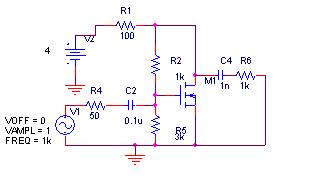yawijaya
Member level 2
- Joined
- Aug 18, 2009
- Messages
- 42
- Helped
- 0
- Reputation
- 0
- Reaction score
- 0
- Trophy points
- 1,286
- Location
- New Freedom, PA-USA
- Activity points
- 1,625
mos switch
I learned this a while back when i was in college, and now i need to re -learn this again...anyway, please take a look at the picture

For what i know this circuit should give me an output either the top or bottom half of the input sinusoidal wave. The datasheet of the transistor says that vgs is 2-4V. but my output is just not what i expected.


I think i'm missing one important concept but can't recall it..ANy suggestion?Thanks for the help!
I learned this a while back when i was in college, and now i need to re -learn this again...anyway, please take a look at the picture

For what i know this circuit should give me an output either the top or bottom half of the input sinusoidal wave. The datasheet of the transistor says that vgs is 2-4V. but my output is just not what i expected.


I think i'm missing one important concept but can't recall it..ANy suggestion?Thanks for the help!